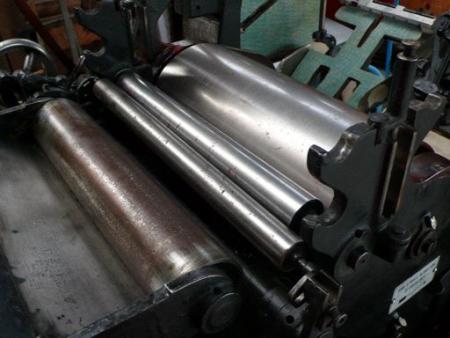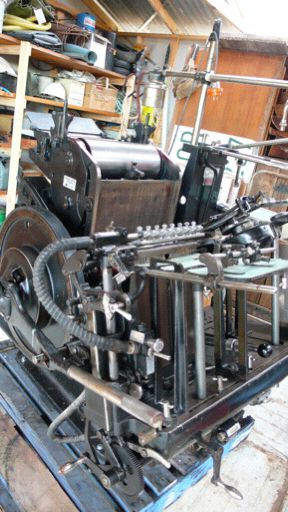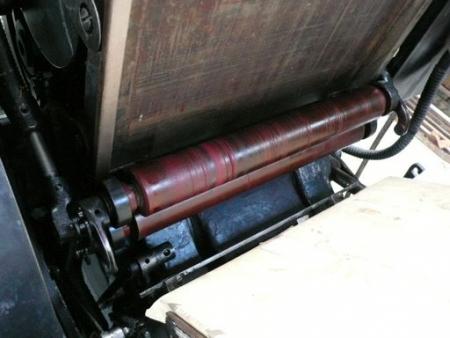Please help me with my press.
Hi Everyone!
Well I’m racking up the posts here on BriarPress!
After getting a whole bunch of stuff together to do some test prints on my 10x15 Heidelberg Windmill….well when I got to Tas it seems I have some work to do to get the thing running first! Argh!
Unfortunately the rollers are in pretty bad shape so I see I will have to get some new ones.
But it looks like I have some parts missing (!!!)….I think the man I bought it off he didn’t use it so maybe these parts are still in his press-room…I hope. And he just didn’t know they were supposed to be there.
Soooo….I’ve attached some pics and I was wondering if someone could name the parts I need and if there’s anything else glaringly obvious missing.
Firstly I need a bolt that holds one of the little feed rollers on. I’ve got one of them but not the other.
And I think there is meant to be another roller there too because it looks like the BIG metal roller doesn’t touch any of the others so the ink wouldnt transfer.
Don’t know where I’m going to get one of these. Especially in Aus. I hope the seller has them still. Are they relatively easy to find?
All this money I need to spend - All the more reason to win this $15K I’m up for!! ;-)
(let me know if more photos are needed)

part missing 2_m.jpg

part missing_m.jpg

press_m.jpg

rollers_m.jpg
From the photos it appears there are several things missing. the roller with the slotted mounts is in the wrong position. It is a rider roller for the forme rollers.
The inking system is continuous by using alternate metal and rubber rollers; as follows
1. Metal ink duct roller
2. Rubber transfer roller (identical to the forme rollers)
3 Oscillating small metal transfer roller. (fixed/ non removable)
4 Rubber distributing roller
5 Metal ink drum (fixed/ non-removable)
6 Metal roller on top of number 4 held in by sprung clips
7 two rubber forme rollers
8 Metal rider roller between the two forme rollers (only used when heavy inking; normally not needed)
Suggest you download Heidelberg parts list from Boxcarpress to give details of what is needed.
HAP_1.jpg
HAP_2.jpg
Hello Kitty—
I believe roller number 4 in Bern’s list is also identical to the form rollers. So it looks to me as though you need four
identical rubber rollers on their cores. Probably you can find these on this site, or in any large city that has a roller maker to the printing trade. Do not throw the old rollers away because the metal cores are needed to make the new rollers. If you are lacking cores too, the price will be higher, but probably not prohibitive, and certainly cheaper than buying from Heidelberg. If you replace just the two form rollers, you can use the beat-up rollers you have now in the ductor and distributor positions, although this would be just a temporary makeshift, far from ideal.
The top metal roller is another matter—best to hope your seller has it about somewhere. Your press looks to be an earlier model than any I have seen, and it could be that my sense of what goes where is inaccurate. On more modern presses, for instance, the top metal roller stays on the press and swings away for washup. I’m not sure how it mounts on your press.
Good luck with your beautiful adventure! Brian
Hi Brian and Kitty,
I agree with Brian that roller 4 is the standard forme roller.
Also on closer examination of the photos I suggest that this press is probably early 1930s vintage as there does not appear to be any wash-up device, or any guard around that flywheel
As far as I know these features were incorporated in the models exported from Germany immediately after the second world war.
Another thing that is missing is the plate which surrounds the chase lock just above the type bed.
Also there does not appear to be any central lubrication system.
Ah thanks! So informative!
So I need to get a total of 4 new rubber rollers, reusing two of the cores on the originals plus 2 completely brand new.
And also locate the small metal roller that sits above the rubber distributor.
Bern, I think I do have that plate which surrounds the chase lock. It has numbers written on it right? Cos that was loose and I wasn’t sure where it went!
hehe I was wondering where the wash-up device went!
As for lubrication - well I have spotted a few tiny holes for oil to go into but nothing central, no.
The story of this press from the man I bought it off….He said he bought the business off an old man some years ago and it came with the Windmill and a GTO. The old guy had been in the business 25 years plus but I guess only used the Windmill for numbering. Didn’t care much for laying the chase flat when packing it as it seems the lead strips are what has done all the damage to the rollers. Don’t know how the rollers missing from the top could have been misplaced.
VERY interesting to hear how old this one is….I was assuming mid-60s but maybe not!
Hi Kitty,
This is definitely a pre-war press, not a mid 60s.
The numbers on the plate are an aid for inking, and co-relate to similar numbers which should be on a plate on the cover of the ink duct.
The operator would note the number where he needed to adjust the ink flow, then move to the rear of the machine and adjust the corresponding screw under that number.
If this machine was used mainly for numbering, then that could be the cause of the cuts in rollers; the plungers of the numbering machines are above type high and dig into the roller surface.
Hi again, Kitty,
The serial number of your press should be stamped into the right hand corner of that big main frame on which the feed table standards are mounted.
Listed below are details I obtained from a Used print M/c website; only a guide ,cannot gaurantee.
Heidelberg 10 x15 Auto Platen
Serial Nos List
Number shown is last machine made for that year
1950 35676 1951 39259
1952 42991 1953 47050
1954 101721 1955 106860
1956 111871 1957 116666
1958 121371 1959 124973
1960 130004 1961 135262
1962 139886 1963 144480
1964 149606 1965 154622
1966 159254 1967 163514
1968 167955 1969 172892
1970 177179 1971 180182
1972 182820 1973 185540
1974 187618 1975 188800
1976 189883 1977 190925
1978 191746 1979 192514
1980 193209 1981 193774
1982 194188 1983 194516
1984 194743 1985 194999
1986 Prod. Halt
Hope this helps.
Thanks Bern!
The only number I could find on the press was down near the counter. Its a little metal plate that is stuck there with tape so it looks like it came off at some point.
It says
Type: H222
Nr: 34635
Which if that is the serial number it is definitely before the 50’s according to the list you posted. Not by much though! Maybe mid 40’s then? I would guess it depends on how many they were producing at the time. And to find it in Aus…I wonder how many there are here from that era!
Good news also - I went with Dad yesterday to a print workshop in Hobart where they use a much newer 10x15. The man there gave me a number of someone in Melbourne who supplies parts for the Heidelbergs. So I shouldn’t have too much trouble with getting the new rollers. Hopefully he will have the metal one I need too.
The serial number is usually on the right hand side at the base of the delivery table. An operating manual is very informative for these windmills. good luck
Hi Kitty, Your press is a Heidelberg Superspeed and dates from just before or just after World War Two. I can date it approximately by the number found on the ‘table’. Stand as if you are about to put the chase in, hands down by your sides, and the machine number is almost under your right hand. It’s between the groove and the front edge of the machine, and about 2 inches/5 centimetres from the right hand edge of the press. It will be a five figure number in the range 15,000 to 30,000ish followed by a dot and another character, probably O or E. Heidelberg here in the UK only date presses back to 1950, but a keen member of staff had a couple of numbers from machines of known vintage. 17??? was approx 1935, up to 25??? which was approx 1939. I use a Superspeed myself, number 22916 (.0) which he dated 1937, and I know the Power House Museum in Sydney, Australia have a Superspeed, number 20120, known to have been supplied new in 1937.
The machine does not have the ‘one shot’ central lubrication system as on the post war models, so you will have to go round with the oil can. I find it easier to oil than my newer presses which have oil nipples which need an oil gun to force oil in, and were used to stop the oil holes clogging up with anti set-off powder and spray. The only snag with the old machines is that you have to search for holes to oil, and invariably realise you’ve forgotten one when you start running the press!! Open the door in the back of the machine and near the various pivots and bearings you’ll see what look like little ‘trays’ built into the parts. These need oil putting in them, and they should also have what appear to be strands of wool lying in them, which then disappear into the oil conduits. This is the ‘wick and well’ system. As long as the wicks are in place you only need to put oil in the ‘trays’ (wells). There is also a well under each end of the ‘wrong’ roller in your picture. These have lids which lift off, and the lids are attached to the machine with short chains.
As for parts you’ll need the steel distributor roller mentioned in other posts, and do you have the bearings for it and the rubber roller that goes underneath? These bearings fit down the slots on the uppermost part of the machine, then the spring loaded catch is swung round to hold them in place.
The machine looks like a pre-war/post war hybrid to me, but I’m no expert. It has the speed control handle on the front, and the black ball on the impression handle seems early 1950s as does the support frame above the pump. Roller system and tracks are Superspeed. Perhaps Heidelberg resumed production after the war with an improved Superspeed before they introduced the post 1950 models which are in such common use today all around the world.
I love my Superspeed. I ran a job on it last week totalling 22,000 impressions, and the room resonates with a lovely deep hum when it’s running. Magic!
Hope my ramblings help. Good Luck.
My press is #14917 and is a 1931 vintage.
Perhaps the major difference could be bearings, my 1931 has only two ball bearings in the whole machine, both for the flywheel. All others are bronze bushings with neat internal spiral oil grooves.
Dan
Glad you can date your machine so accurately.
It has bronze bushes all over, and the post-1950 models have even more - effective lubrication being the key to the longevity of these presses. I was once told if I kept the machine well oiled it would run forever!
Hope Kitty’s up and running a year on.
David
I like the history of the machinery if I can get it.
This one came from the son of the original owner and from his conversation the image was early 1930’s. I had to take the press apart to move it and found “6.5.31” stamped into the impression counter frame.
He even thought he had the receipt somewhere but concluded it went out in a roll-top desk that was sold previously. And the price? He was certain his Dad paid $1,600; this was in the middle of the Depression.
Apparently it was paid off in installments as the print shop got work. For any Canadians out there, the importer was Manton Brothers.
Dan
Nice snippet of information that Dan. Just looked under my impression counter and found the date 9.7.37, so the bloke from Heidelberg UK with his private archive was correct when he said 1937. I felt the machine number was high enough to be 1938. It means my oldest press is 50 years older than my newest, a GTO52 from 1987, and have a ‘halfway house’ model T from 1962.
Talking about 1938, I met a man who was trying his hand at printing about 15 years ago, and he said he knew someone who had an unused Superspeed platen, still in the original crate, from 1938!! Would love to see that!
David
David, I absolutely believe there is a guy out there with a new machine in a crate. Reality is stranger than fiction, and it is amazing what turns up if you are patient and lucky.
Dan
I used to have a Flickr page bookmarked of a C&P found fully crated in a barn that was new from the factory. You could see that it was not rusted but covered with oil. I wish I still had the photo. I think it was an Old Style which puts it at 1912 latest.
Stranger things have happen.
Is this the press you were thinking of?
http://www.excelsiorpress.org/forsale/meaghan/cratedpress01.jpg
1930’s New Series C&P.
Check out that slick motor control - and the roller trucks hanging from a wire at the bottom - apparently that’s how C&P packed their trucks. I’ve seen them hanging there on other presses.
BTW - last I heard, that press is still in its crate…. and stored in a barn among other orphaned/rescued presses somewhere out in the midwest…
I was studying these photos to try and figure out the best way to crate a 10x15 C&P safely for a long trip. My press *was* destined for overseas shipment, but that’s another story….
- Al
Hi Everyone, I have a machine that seems very close in number to Kitty’s machine. 36948.
Does that mean it would be similar in age? I am currently in the process of cleaning it all up to print on it again. I am having a lot of trouble getting the paper feed to be consistent. It takes one page some times and 10 others. David, its sounds like you have a similar machine, any tips on how to improve this problem I have?
Thanks
i would start by cleaning the air filter which is where the air hose attaches at your trip to start your paper feeding. this filter can get a lot of paper dust and will really mess up your feeding. Then its a matter of getting your pile height, it should be 1/4” below your sheet separators. you need to blow the sheets up to the separators, and you can tilt the succer bar so you don’t get as much suction. once you get the hang of it this press will feed great.
Here in the UK I have seen a platen with a serial number T 1010/7, would have thought that it should be all figures and therefore may be. Can anybody date this machine formw please?. Is there a list of serial numbers for older machines.
thanks
That’s likely a part number.
The serial number is on the right front corner, seen in this post: http://www.briarpress.org/20767
Hi. I recently bought a platen with serial number 32548 E.
It is all hand oiled and no washup tray. I agree that you need to look carefully for all the oiling points. Once you know they are it is quick and easy. I used candle wick cotton where there was a need for drip feed from the oil resivours internally and below the inking roller as some were missing.There is a grease cup on the air pump that need refilling. It runs with a variable speed pulley. It has a large one and half hp single phase motor which did not hesitate one bit. I did a 100,000 run on it and was cruising at 4000 impresions ph. I am looking for some parts as they have worn. Can anyone identify the year it was built and where to get parts for it? Graham
Hello All,
I have stated a register of letterpress equipment, so please feel free to add your details and also help to date your machinery.
Please take a look at:
www.register-my-press.co.uk
Thank you